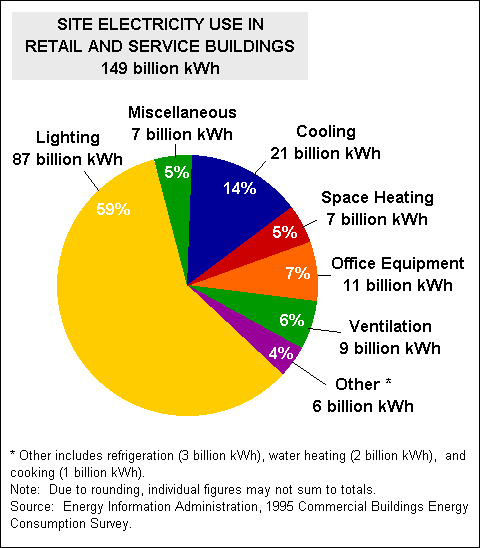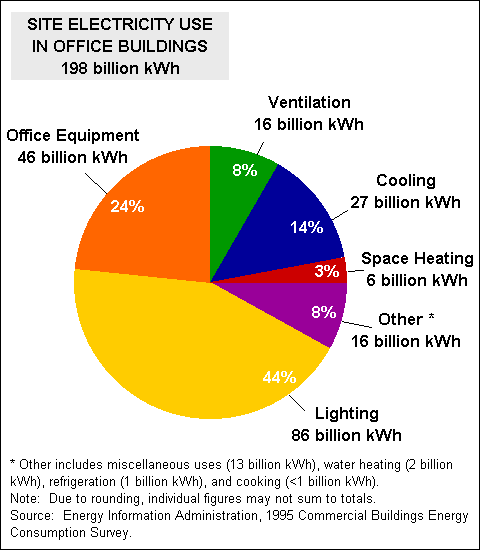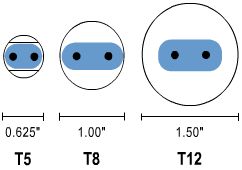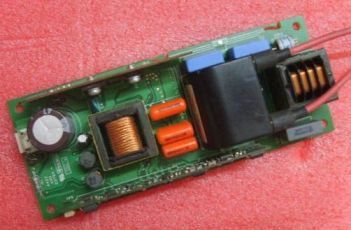Energy Efficiency
Did you know, that LIGHTING is the single most electricity consuming energy user in schools, hospitals, office and other commercial (i.e. retail and service) buildings in the US?

Retail and service buildings use 149 billion kWh (or 508 trillion Btu) of site electricity (electricity consumed within the building) each year. This electricity is used for a variety of different purposes, the most being used for lighting (59%). LUXADD can help you to reduce these costs up to 75%.

The majority of this electricity is used for lighting (44%) and office equipment (24%) (such as computers, printers, faxes and photocopiers). Both lighting and office equipment produce heat, requiring more air conditioning - another predominantly electric end use - to cool the buildings. LUXADD can instantly improve your energy efficiency up to 75% and also save on your airconditioning electricity costs.
And if you look at the lighting energy usage of all building types, you will find the following:
- Retail and Service: 59%
- Education: 56%
- Office: 44%
- Health Care: 44%
- Food Service: 30%
(see: http://www.eia.doe.gov/emeu/consumptionbriefs/cbecs/pbawebsite/office/office_howuseelec.htm)
Energy efficient use of lighting
There are two main ways to save energy used for lighting. One is to use more energy efficient lighting. The other is to reduce the operating time of the lighting.
Fluorescent lamps are so far the most popular type of lamp used in offices and many warehouses. The most common type of fluorescent lamp is tubular and linear in shape. There are three generations of linear tubular fluorescent lamps: 1st generation T12 lamps with a diameter of 38 mm (1½"), 2nd generation T8 lamps with a diameter of 26 mm (1") and the 3rd generation T5 lamps with a diameter of 16 mm (5/8").
T5 fluorescent lamps have a higher luminous efficacy than T8 or T12 lamps. Luminous efficacy indicates how much light a lamp generates from the energy it consumes. The higher the value, the more energy efficient the lamp is. The luminous efficacy of T5 lamps is about 100 lm/W, while those of T8 and T12 lamps are only about 80 lm/W and 70 lm/W respectively.
All fluorescent lamps need ballasts to maintain the current passing through the lamp at a certain value. There are mainly two types of ballasts: electromagnetic ballasts and electronic ballasts. Although electronic ballasts are more expensive, they have higher energy efficiency and can save money in the long run. Besides, electronic ballasts generate less heat during operation and therefore help reduce energy used for air conditioning.
The energy used in lighting systems can also be reduced by using automatic controls. For example, infrared or ultrasonic motion sensors are used to detect the presence of people and automatically turn lights on or off accordingly.

T5 flourescent lamps -
The best choice when it comes to energy efficiency
T5 lamps are fluorescent lamps that are 16mm or 5/8" of an inch in diameter. Differences in length and socket pin design versus conventional fluorescent lamps prevent any confusion problems with electric circuits or human factors. This section focuses on the physical characteristics of T5 systems compared with T8 systems and T12 systems.
What does T5, T8 and T12 mean?
The "T" in lamp nomenclature represents the shape of the lamp-tubular. The number following the "T" usually represents the diameter of the lamp in eighths of an inch (1 inch equals 2.5 centimeters). T5 lamps have a diameter equal to 5 times an eighth of an inch, or 5/8". These lamps are approximately 40% smaller than T8 lamps, which are one inch in diameter, and almost 60% smaller than T12 lamps, which are 1½" in diameter. The picture above shows diagrams of lamp ends of T5, T8, and T12 lamps. The picture also shows that pin base type of T5 lamps is different from that of T8 and T12 lamps. T5 lamps have a miniature bi-pin base while T8 and T12 lamps use a medium bi-pin base. (see: http://www.lrc.rpi.edu/)

Are T5 lamps the same length as T8 and T12 lamps?
T5 lamps are slightly shorter than T8 and T12 lamps and therefore cannot be used as replacements for the larger lamps. You will always need an adapter if you wish to retrofit from T12 to T5 or T8 to T8. Additionally, you need to eiher manually change the ballast by opening the lamp fixture or use a conversion adapter (i.e. LUXADD express Retrofit Kit series). The table compares lengths of T5 lamps with T8 and T12 lamps.
| Table. Linear Lamp Lengths | ||
|
|
||
| Nominal Length (ft) | Actual Length | |
| T5 (mm) | T8 and T12 (mm) | |
|
|
||
| 4 | 1149 | 1199 |
| 8 | tbd | tbd |
|
|
||
|
Table. Linear Lamp Lengths |
||
|
|
||
| Nominal Length (ft) | Actual Length | |
| T5 (in.) | T8 and T12 (in.) | |
|
|
||
| 4 | 45.2 | 47.2 |
| 8 | tbd | tbd |
|
|
||
Energy efficiency of flourescent lamp ballasts
(See: http://en.wikipedia.org/wiki/Electrical_ballast)
Instant start
An instant start ballast starts lamps without heating the cathodes at all by using high voltage (around 600 V). It is the most energy efficient type, but gives the least number of starts from a lamp as emissive oxides are blasted from the cold cathode surfaces each time the lamp is started. This may be used for installations where lamps are not turned on and off very often, however, since daylight harvesting and occupancy sensors are becoming mandatory, instant start ballasts are not the best choice.
Rapid start (used for T12 to T5 express Retrofit Kit)
A rapid start ballast applies voltage and heats the cathodes simultaneously. It provides superior lamp life and more cycle life and only uses slightly more energy as the cathodes in each end of the lamp continue to consume heating power as the lamp operates. A dimming circuit can be used with a dimming ballast, which maintains the heating current while allowing lamp current to be controlled.
Programmed start (used for T8 to T5 express Retrofit Kit with occupancy sensor)
A programmed-start ballast is a more advanced version of rapid start. This ballast applies power to the filaments first, then after a short delay to allow the cathodes to preheat, applies voltage to the lamps to strike an arc. This ballast gives the best life and most starts from lamps, and so is preferred for applications that provide additional energy efficiency by using a motion detector switch or occupancy sensor (mandatory in most office buildings).








